BEBEKAN 6
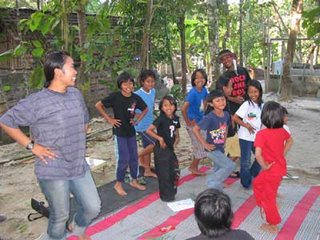
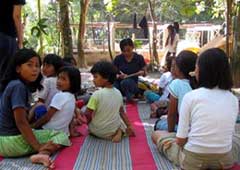 Three Indonesian voluntary coeds (one is from Bali, and they all attend the Faculty of Psychology) have settled in Bebekan and begun the playgroup with the children of the village under the tent given by the Atlas NGO. As the school holidays will start in a week and last until July 16, we will develop the activities under this tent and perhaps organize one or twice an excursion by bus so that the children see other things than the ruins of their village. I put the three coeds in liaison with a French psychotherapist, Judicaëlle, a voluntary also, specialized in post-traumatic situations. She worked with the Mother Theresa organization for 2 years in the Rwanda refugee camps after the genocide, and in Sri Lanka after the earthquake. She is wonderful and will impart some of her experience to the three Indonesian coeds.
Three Indonesian voluntary coeds (one is from Bali, and they all attend the Faculty of Psychology) have settled in Bebekan and begun the playgroup with the children of the village under the tent given by the Atlas NGO. As the school holidays will start in a week and last until July 16, we will develop the activities under this tent and perhaps organize one or twice an excursion by bus so that the children see other things than the ruins of their village. I put the three coeds in liaison with a French psychotherapist, Judicaëlle, a voluntary also, specialized in post-traumatic situations. She worked with the Mother Theresa organization for 2 years in the Rwanda refugee camps after the genocide, and in Sri Lanka after the earthquake. She is wonderful and will impart some of her experience to the three Indonesian coeds. Wednesday July 14. We gave 2,000,000 rps (about 180 euros) to the women of Bebekan so that they can buy the ingredients necessary to prepare the ceremonial meal of the following day, "syukuran" or "selamatan". We suggested to them the idea to organize such a meal which would allow for the first time all the inhabitants of Bebekan to gather together for prayers, songs, short presentation speeches by the volunteers about the assistance to Bebekan since the earthquake, and partake in a communal meal for some 600 people. The women of Bebekan have thus diligently spent all of Wednesday afternoon cooking the meal, always according to the gotong-royong principle, to prepare this "festive and meditative" meal.
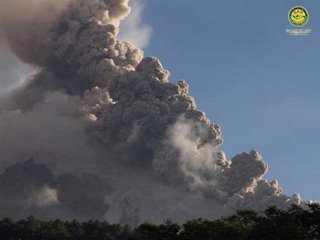
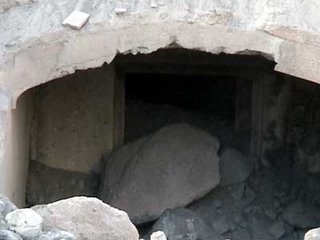 Wednesday evening. The Merapi volcano whose alarm status had been lowered the day before from "awas" (alert) to "siaga" (ready), spit an enormous volcanic cloud of more than 7 km which reached the hamlet of Kaliadem, where there are small restaurants which overhang a ravine where the lava runs out. It is one of the local tourist resorts, because of its superb view on the volcano. It is also the location of two sacred sites, the Elephant Stone and the White Banyan Tree, which are the central subject of the book I wrote 8 years ago about the Merapi volcano. The local population was able to flee in time, except for a SAR rescuer and a villager who took refuge in the bunker of Kaliadem. This bunker can accommodate 50 people with enough oxygen for 5 or 6 days. But several meters of lava covered the bunker. Asep, the coordinator of the SAR rescuers with whom I work every day in Bebekan, left at once for the rescue station on the volcano. At 22.00, I alerted the French Firemen Without Borders. I thought they had already left the country but they had been replaced by a new team of four people, but they were only equipped with medical material for the casualties of the earthquake and therefore did not have any fireproof equipment with them ! Nevertheless I led them to the rescue station. They left at midnight for the site with a fire engine of Yogyakarta, an ambulance and the rescue truck of SAR. In the surrounding darkness it was almost impossible to approach the bunker, hidden under the boiling lava which the fire engine tried to cool with water jets while volcanic clouds continued to fall. By 4 o'clock in the morning, they had no choice but to retreat and turn back hastily. The French firemen were very impressed by the organization of the SAR rescuers and its commander, Jabrik, who directed the operations in an orderly way and with an acute sense of the risks involved. More than ever, the firemen are eager to come back to Indonesia in a few months and train the SAR volunteers in rescue techniques and perhaps to forward to them some equipment. Thursday morning. A bulldozer made its way to the bunker but the constant volcanic clouds so terrorized the driver of the bulldozer that at one point he had to run away. Asep and I bought motorcycle goggles (the same ones used by the people of Bebekan when clearing the rubble) so that the rescuers could at least protect their eyes. Asep went north to the volcano, and I south to Bebekan.
Wednesday evening. The Merapi volcano whose alarm status had been lowered the day before from "awas" (alert) to "siaga" (ready), spit an enormous volcanic cloud of more than 7 km which reached the hamlet of Kaliadem, where there are small restaurants which overhang a ravine where the lava runs out. It is one of the local tourist resorts, because of its superb view on the volcano. It is also the location of two sacred sites, the Elephant Stone and the White Banyan Tree, which are the central subject of the book I wrote 8 years ago about the Merapi volcano. The local population was able to flee in time, except for a SAR rescuer and a villager who took refuge in the bunker of Kaliadem. This bunker can accommodate 50 people with enough oxygen for 5 or 6 days. But several meters of lava covered the bunker. Asep, the coordinator of the SAR rescuers with whom I work every day in Bebekan, left at once for the rescue station on the volcano. At 22.00, I alerted the French Firemen Without Borders. I thought they had already left the country but they had been replaced by a new team of four people, but they were only equipped with medical material for the casualties of the earthquake and therefore did not have any fireproof equipment with them ! Nevertheless I led them to the rescue station. They left at midnight for the site with a fire engine of Yogyakarta, an ambulance and the rescue truck of SAR. In the surrounding darkness it was almost impossible to approach the bunker, hidden under the boiling lava which the fire engine tried to cool with water jets while volcanic clouds continued to fall. By 4 o'clock in the morning, they had no choice but to retreat and turn back hastily. The French firemen were very impressed by the organization of the SAR rescuers and its commander, Jabrik, who directed the operations in an orderly way and with an acute sense of the risks involved. More than ever, the firemen are eager to come back to Indonesia in a few months and train the SAR volunteers in rescue techniques and perhaps to forward to them some equipment. Thursday morning. A bulldozer made its way to the bunker but the constant volcanic clouds so terrorized the driver of the bulldozer that at one point he had to run away. Asep and I bought motorcycle goggles (the same ones used by the people of Bebekan when clearing the rubble) so that the rescuers could at least protect their eyes. Asep went north to the volcano, and I south to Bebekan.
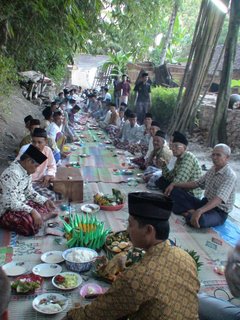
Thursday afternoon. The villagers have unrolled their mats according to a star-pattern layout, starting from the center of the village and spreading out on two roads and the slopes of the small hill leading to the cemetery, digging their place in the middle of the ruins and the endless and ominous rubble piles. Everyone was wearing their festival clothes, the women (who in this village do not usually cover their head) their veil and their batik, the men their sarong and black peci (small hat). We were full of admiration to see them so well dressed in the middle of their ruined lives.
That same morning, I hurried to recover 200 plastic plates and glasses offered by one of the daughters of the sultan in the posko installed in her house, and I bought the remaining 200 sets in a store before hurrying back to Bebekan. We were joined by three Frenchmen working for the Atlas NGO, responsible for the rebuilding of the villages. Knowing that the Indonesian government prohibits foreign NGOs from intervening in the rebuilding of permanent houses, they do some research for the rebuilding with recycled materials, classified as "semi-permanent", a label which will allow to "bypass" this law. They wanted to see what the situation was in Bebekan. We were joined also by Vincent, a French friend who has lived for many years in Yogyakarta. Since the beginning of the earthquake, he and his Indonesian wife, Puji, have set up a posko in their house : they constantly collect aid and redistribute it to the people or villages in need, relying on phone calls made to a local community radio and various friends. Vincent has already given a lot to the village of Bebekan and on this Thursday he brought 127 packages, one for each family, containing rice, sugar, soap, etc.
 The ceremonial meal opened with a "tahlilan", prayers for the dead, followed by a "dikir", an repetitive chant of the name of Allah, mantras to clean the heart, practiced by the Sufi Moslems as are the villagers of Bebekan. Then I was invited to describe how I arrived in this village. At my sides stood Emi, the woman who led me to Bebekan on the morning of Sunday May 28, after the burial of one her cousins in another district. She told the people of Bebekan that it was her dead cousin who had made us meet and help Bebekan. Then the young men of the village brought the dishes, one of which is the famous "nasi tumpeng", a rice dish in the shape of mountain or volcano with two large red peppers planted at the top, one horizontally (representing the terrestrial and mundane world), the other vertically (representing the spiritual world), and at their crossing a small ruail egg. The plates circulated from hand to hand, white rice, "sayur urap", carrots, vapor-cooked soya mixed with grated coconut, beef stew, lemper (rice stuffed with meat and cooked in a banana leaf), "naga sari" (banana, flour and palm sugar cooked in a banana leaf), glasses of ultra-sweet tea...
The ceremonial meal opened with a "tahlilan", prayers for the dead, followed by a "dikir", an repetitive chant of the name of Allah, mantras to clean the heart, practiced by the Sufi Moslems as are the villagers of Bebekan. Then I was invited to describe how I arrived in this village. At my sides stood Emi, the woman who led me to Bebekan on the morning of Sunday May 28, after the burial of one her cousins in another district. She told the people of Bebekan that it was her dead cousin who had made us meet and help Bebekan. Then the young men of the village brought the dishes, one of which is the famous "nasi tumpeng", a rice dish in the shape of mountain or volcano with two large red peppers planted at the top, one horizontally (representing the terrestrial and mundane world), the other vertically (representing the spiritual world), and at their crossing a small ruail egg. The plates circulated from hand to hand, white rice, "sayur urap", carrots, vapor-cooked soya mixed with grated coconut, beef stew, lemper (rice stuffed with meat and cooked in a banana leaf), "naga sari" (banana, flour and palm sugar cooked in a banana leaf), glasses of ultra-sweet tea...
Asep joined us after having spent the day on the volcano with the rescuers who still had not succeeded in clearing the door of the bunker completely. As the day was falling, the villagers scattered to the sounds of percussion and gongs of the Reog group which we are helping to recreate. We ordered all the missing instruments and they will be ready in 15 days. Before buying the costumes, we asked the villagers to give us a detailed list of what they needed. They came up with the list of the 60 members, dancers, musicians, manager, "secretary", (the youngest must be at least 17-year old : since the dances are trance dances, teenagers are only authorized to join the group at their majority and if they are considered to be "mature enough" to face a trance).
Sunday afternoon. We all gather in my home (built on the slopes of the volcano but still quite far from the crater) : there is Asep, the students and the persons in charge of the Reog troupe. We are here to discuss the good organization of their group. If I can find a minibus, we could also bring along some children of Bebekan to take them out of their usual surroundings.
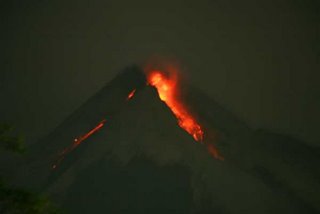
Friday morning, 8 o'clock. Volcanic clouds, transporting rain of ashes and sand, continue to spew out of the volcano whose top has transformed into a lunar landscape. Mbah Maridjan, the guardian of the volcano, remains faithfully at his station in his village, at a distance of some 500 meters from the volcanic clouds. I receive a message from Asep : the rescuers have just entered the bunker. Slumped against the door, they found the body of the SAR worker, burned to death and asphyxiated, and inside the bunker, in the bathroom, the body of the villager, dead also under the same conditions. It seems that the SAR rescuer who was responsible for the evacuation of the population of Kaliadem went to look for a latecomer and when both realized they did not have time to flee they took refuge at once in the nearby bunker. Either they did not close the door of the bunker properly or the bunker was badly designed. In theory, this kind of bunker is designed to withstand high temperatures and pressure and magma and lava flows.
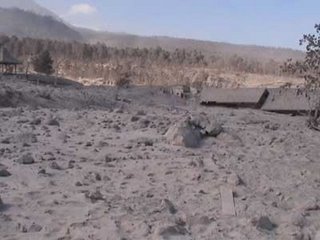 The death of these two men in the bunker fills me this morning with an immense sorrow. The earthquake killed more than 6000 people, but in the heat of action I was undoubtedly kept from tears. Perhaps it is all the sadness accumulated unconsciously since the earthquake. Perhaps because I feel such a strong link to the volcano. Perhaps also because I work in close cooperation with some of these young, courageous and devoted volunteers of SAR.
The death of these two men in the bunker fills me this morning with an immense sorrow. The earthquake killed more than 6000 people, but in the heat of action I was undoubtedly kept from tears. Perhaps it is all the sadness accumulated unconsciously since the earthquake. Perhaps because I feel such a strong link to the volcano. Perhaps also because I work in close cooperation with some of these young, courageous and devoted volunteers of SAR.
Mati abu di utara
Mati batu di selatan
Air mata pun berdebu
Death by ashes in the north,
Death by stones in the south,
Our tears have become dust.
Thank you for your support.
Elisabeth

0 Comments:
Post a Comment
<< Home